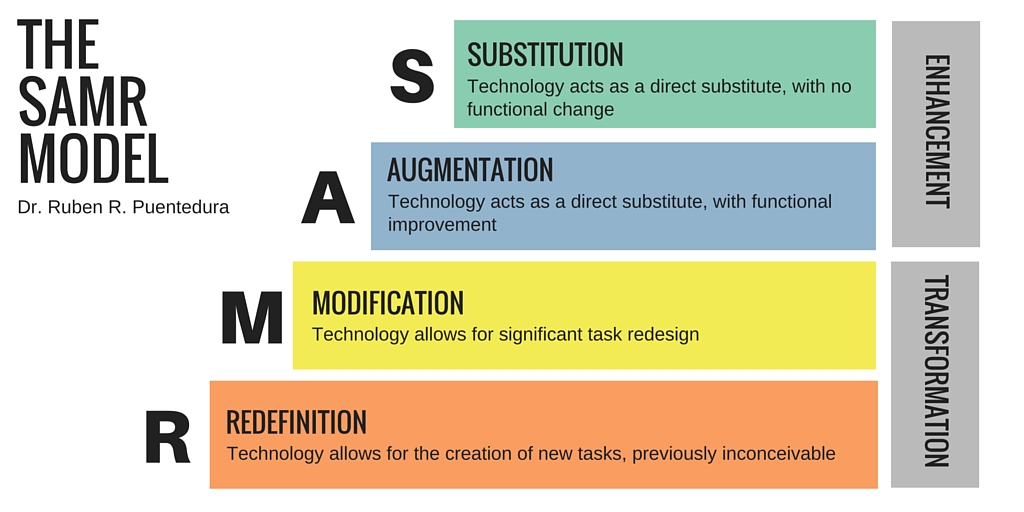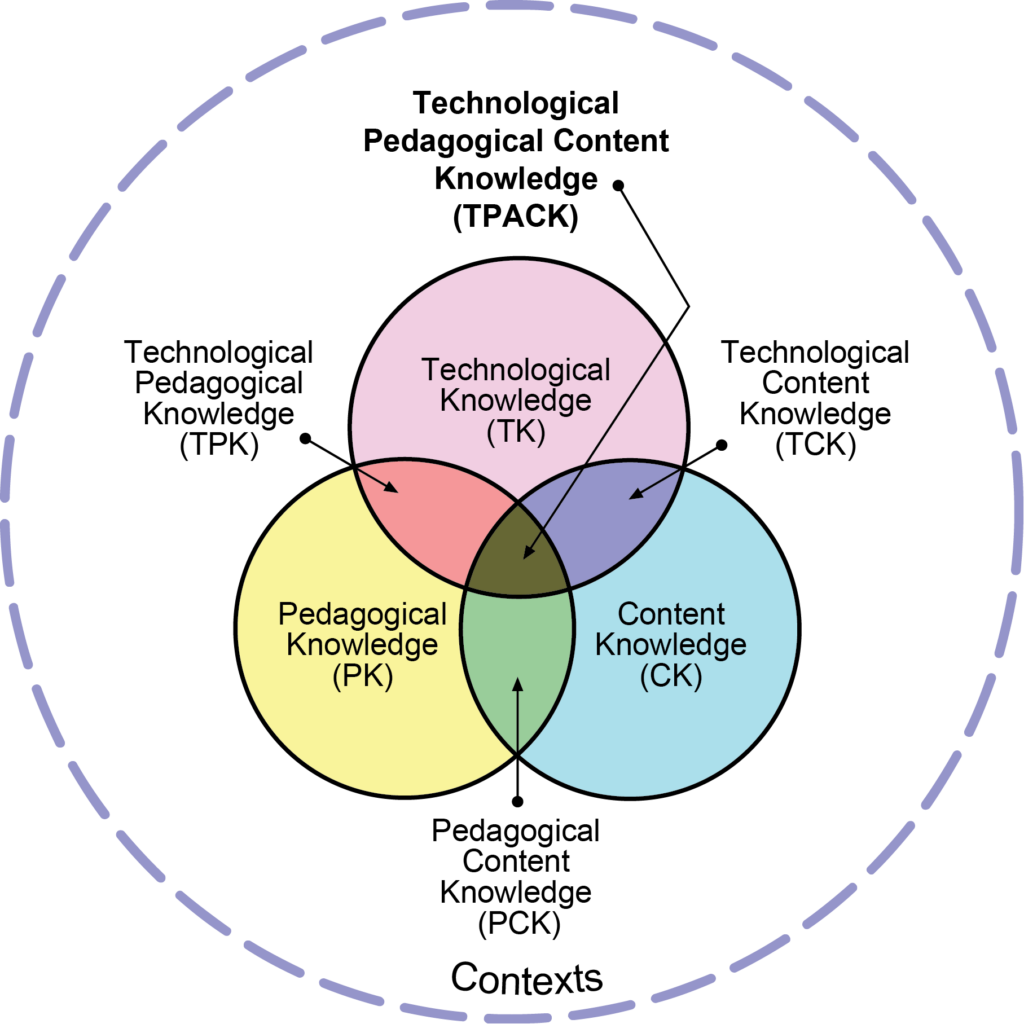During my experience in instructional technology, I noticed an evolution in understanding technology integration that goes from seeing tech as “something extra” (often as an afterthought) to becoming embedded in the lesson design. This shift in thinking becomes evident when educators focus on lesson outcomes and planning with technology that supports the outcomes, rather than focusing on the tech tool and forcing a lesson to align. To aid in this evolution of thought around technology in lesson design, a variety of technology integration models emerged. Three in particular:
- SAMR (Substitution, Augmentation, Modification, Redefinition)
- TPACK (Technological Pedagogical Content Knowledge)
- TIM (Technology Integration Matrix)
These technology integration models help educators plan, implement, and evaluate instruction effectively, and it’s an added bonus that they come in the form of a fun acronym. Each model has its place and should be used conjunctively to ensure educators are using technology in meaningful and purposeful ways. I will share a brief description of these three models and when they should be used. Let’s take a look at them!
What Is the SAMR Model?
The SAMR Model is one of the most widely used models for technology integration. It’s the first model I learned when I started in instructional technology. Developed by Dr. Ruben Puentadura, SAMR categorizes technology use into four levels:
- Substitution
- Augmentation
- Modification
- Redefinition
Often it is pictured in a ladder-like form and presented as levels ultimately reaching Redefinition. While I am more partial to the idea of SAMR as a swimming pool, I do not find this the optimal model for planning a lesson.

Planning a lesson by thinking, “I will achieve Augmentation by using…” places the focus on technology instead of the lesson objective. Additionally, redefining all lessons all of the time is exhausting. Sometimes, substituting a hand-written draft or worksheet with a digital version may be more than enough.
Instead, look at SAMR as an evaluative tool for technology integration. Wait until after the lesson is over and, using SAMR, gauge achievement of the levels based on student use of technology for learning. By looking at the lesson after the fact and seeing what level of SAMR the technology achieved, a teacher has a better idea of how students used the technology to learn. This will affect how the lesson is delivered in the future and allow the teacher to see if there is a balance between SAMR levels or if an opportunity to venture into a new level is possible.
Two Additional Models
What is the TPACK Model?
Moving beyond SAMR in my understanding of instructional technology, I came across the TPACK model. Developed by Dr. Punya Mishra and Dr. Matthew Koehler, TPACK emphasizes the intersection of Technological, Pedagogical, and Content Knowledge. This is the model I recommend for lesson planning. It looks at the key parts of a lesson rather than the level of technology use when integrating technology.
First, you start with the content standard, move towards the pedagogy (instructional strategy) to teach the standard, and determine what technology tool/application would best support the instructional strategy. Furthering research into this model, Gomez (2015) suggested layering the three rather than intersecting them, showing the “combination of knowledge rather than the intersection of it.” This emphasizes technology as part of the planning process.
What Is the TIM?
After TPACK, the third model introduced to me was TIM (Technology Integration Matrix), developed by the Florida Center for Instructional Technology. It offers a comprehensive framework for reflecting on technology integration in the classroom. It consists of five levels of technology integration:
- Entry
- Adoption
- Adaptation
- Infusion
- Transformation
The TIM focuses on the extent to which technology is integrated into instruction and provides guidance on the progression toward more sophisticated and transformative use.
A colleague, whose background focuses on instructional coaching, shared TIM with me as a way for teachers to reflect on how they integrate technology. I loved this! Reflection is an important part of learning, and the TIM Matrix is an excellent way for teachers to evaluate and grow in their instructional technology use.
How to Choose the Right Technology Integration Model for Your Objectives
When deciding which model to use, I like to think like Michael Fullan (2016, p. 45) who stated “[his point] is simple – make pedagogy the driver and technology the accelerator” and Liz Kolb whose “Learning First, Technology Second: The Educator’s Guide to Designing Authentic Lessons” emphasizes technology’s place as something in service of the learning and not center stage. This means it is crucial to consider the objectives we aim to achieve when selecting a model for technology integration rather than clingy to a model and forcing everything to fit:
- Objective: Lesson design that integrates technology → TPACK
- Objective: Evaluate student use of technology for learning → SAMR
- Objective: Evaluate teacher use of technology in instruction → TIM
In the ever-evolving landscape of education, integrating technology into instruction and lesson design is essential for promoting student engagement and preparing them for the future. All three technology integration models are powerful tools when it comes to technology in learning. However, the combination of the three can empower educators in lesson design, student learning, and professional growth.



4 comments
For those who would like to explore educational technology frameworks in addition to those shown here, visit this website. It features educational technology frameworks that are evidence-based. Find it online at https://go.mgpd.org/etf
With appreciation,
Miguel
With appreciation for the wonderful ideas, Jodi
Thank you so much for this article. This is such a fascinating topic and I love learning more about it.
I took the TIM-T course with the University of Florida and I absolutely loved it. I want to study more about these Technology Integration Models and when to use them. Could you provide me with more resources?
I have also read a lot about two other Technology Integration Model: PICRAT and the 5E model. Have you heard about them too?
Thank you once again.
Hi, Leandro. Thanks for your comment. I wanted to respond to you with a bit more detail than a comment box allows, so I have elaborated on the comment here:
https://www.mguhlin.org/2023/08/comment-hoist-edtech-frameworks.html
I hope you will read it, then come back here to continue the conversation.
Miguel Guhlin